Everywhere you go, people around the world are wearing face masks to prevent the spread of COVID-19.
What was once a staunchly rejected notion by several internationally well-respected health authorities has now become the #1 talking point in the healthcare industry:
“Additional data in today’s [Morbidity and Mortality Weekly Report] showed that immediately after the White House Coronavirus Task Force and CDC advised Americans to wear cloth face coverings when leaving home, the proportion of U.S. adults who chose to do so increased, with 3 in 4 reporting they had adopted the recommendation in a national internet survey.”
“…CDC analyzed data from an internet survey of a national sample of 503 adults during April 7–9 and found that about 62% said they would follow the newly announced recommendations to wear a face mask when outside the home. A repeat survey during May 11-13 showed that the percentage of adults endorsing face mask wearing increased to more than 76%.”
People are desperately scrambling to get their hands on a mask, doing everything and anything they can to ensure they are protected from a potential COVID-19 infection.
I’m here to tell you that all of this panic and chaos is entirely rooted in FEAR, VICTIMHOOD… but most importantly, RAMPANT MISINFORMATION.
This is not your ordinary Jay Campbell conversation about higher consciousness and raising your vibration that goes WAY OVER the head of many of you.
Fighting against the universal widespread use of face masks requires an extraordinarily deep dive into the medical science, unlike anything I have ever done before on this website.
I want to give a HUGE amount of credit to Dr. Jim Meehan for helping me write this article.
His brave stance against the fraudulent findings of mainstream medicine is imperative to discovering the truth about COVID-19.
Table of Contents
ToggleThe Nature of SARS-CoV-2 Transmission
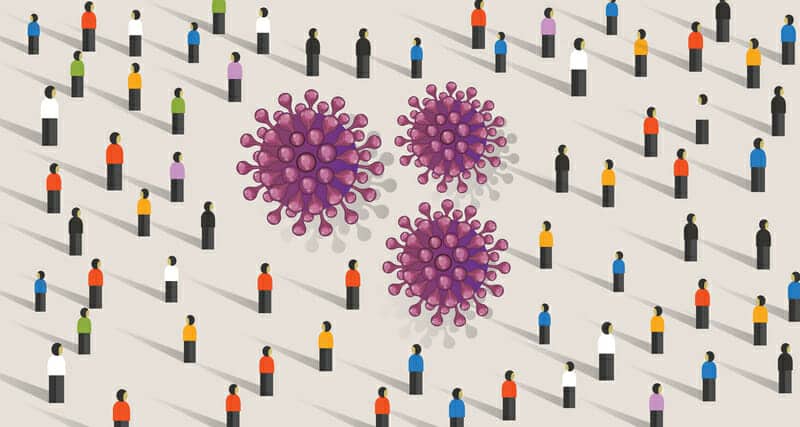
I’m going to drop several important bits of information here which will be relevant in explaining the supposed “effectiveness” of face masks.
The SARS-CoV-2 virus has a diameter of 60-140 nm (i.e. nanometers), and like the original SARS-CoV virus that made international headlines in 2003, it is “predominantly transmitted through indirect or direct contact with mucous membranes in the mouth, eyes, or nose” (Source: PubMed).
This is highly similar to the influenza virus, which has a diameter of 80-120 nm and is spread through similar methods:
“Influenza virus may be transmitted among humans in three ways: (1) by direct contact with infected individuals; (2) by contact with contaminated objects (called fomites, such as toys, doorknobs); and (3) by inhalation of virus-laden aerosols”
And just like the influenza virus, COVID-19 spreads FAST:
“The R0 for COVID-19 is a median of 5.7, according to a study published online in Emerging Infectious Diseases. That’s about double an earlier R0 estimate of 2.2 to 2.7
The 5.7 means that one person with COVID-19 can potentially transmit the coronavirus to 5 to 6 people, rather than the 2 to 3 researchers originally thought.”
“…The researchers estimated a doubling time of 2 to 3 days…how long it takes for the number of coronavirus cases, hospitalizations, and deaths to double.”
“With an R0 of 5.7, at least 82 percent of the population needs to be immune to COVID-19 to stop its transmission through vaccination and herd immunity.”
If you want more “COVID-19 101” intel, I implore you to read my other thoroughly-researched articles about the subject:
- The Essential Coronavirus (COVID-19) Survival Guide For 2020 And Beyond
- How To (Actually) Understand The Coronavirus’ TRUE Global Impact
- COVID-19: Novel Interventions For A Novel Virus
The Masks Used To “Prevent” COVID-19 Transmission
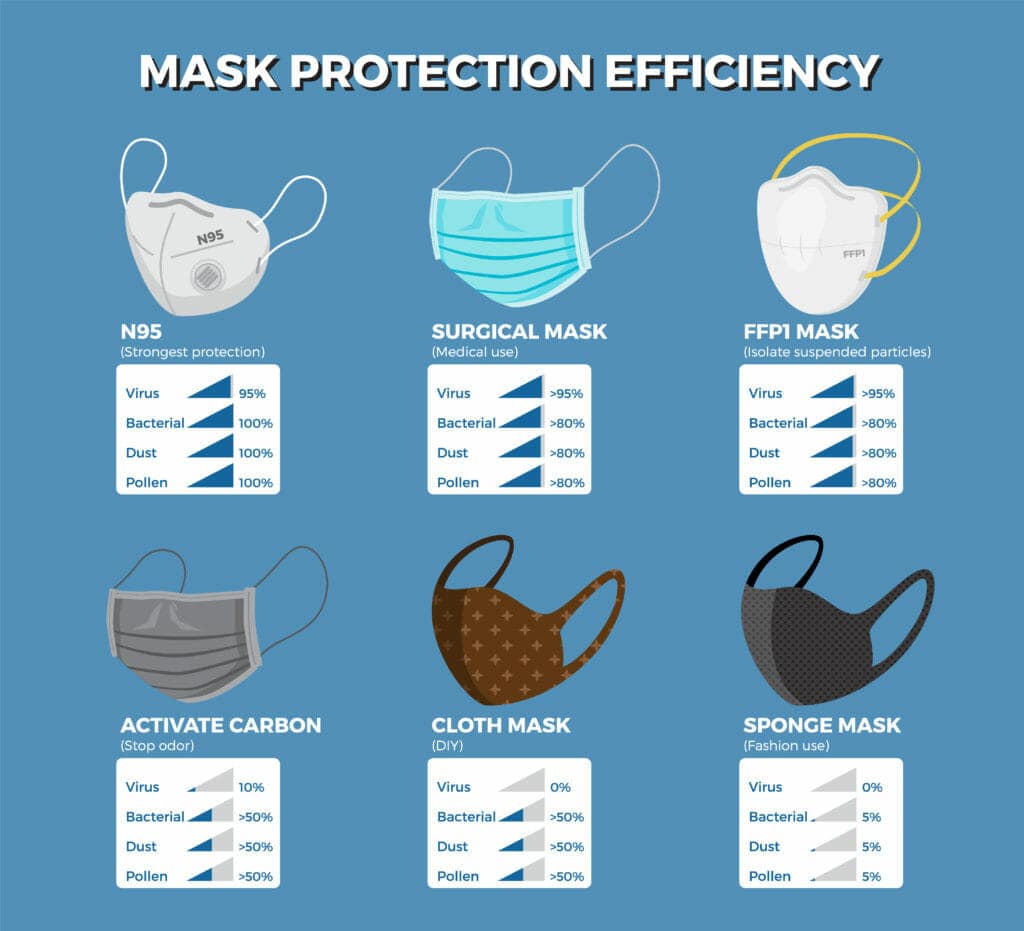
(SOURCE: Vecteezy.com)
What are the types of masks being used to lower the spread of COVID-19, and how well could they theoretically work?
The three types of masks you’ll hear about most often are the following (Source: FDA.gov):
N95 Respirator: “…a respiratory protective device designed to achieve a very close facial fit and very efficient filtration of airborne particles”
Surgical/Medical Mask: “…a loose-fitting, disposable device that creates a physical barrier between the mouth and nose of the wearer and potential contaminants in the immediate environment.”
Cloth Mask: “…a mask made of common textiles, usually cotton, worn over the mouth and nose. When more effective masks are not available, cloth face masks are recommended by public health agencies for disease “source control” in epidemic situations to protect others from virus laden droplets in infected mask wearers’ breath, coughs, and sneezes (Source: Wikipedia.com)
With the understanding of how large the SARS-CoV-2 virus is, let’s take a look at several studies measuring how efficient these masks are at filtering the particles between 0.08-0.22 µm (i.e. 8-220 nm) away from the mouth and nose:
“…N95 FFR filter efficiency was greater than 95%.
“…cloth or homemade masks will have very low filter efficiency (2% to 38%).
Medical masks are made from a wide range of materials, and studies have found a wide range of filter efficiency (2% to 98%), with most exhibiting 30% to 50% efficiency“
The Centers for Disease Control and Prevention (CDC) agrees with these findings:
Surgical Mask Filtration: “Does NOT provide the wearer with a reliable level of protection from inhaling smaller airborne particles and is not considered respiratory protection”
N95 Respirator: “Filters out at least 95% of airborne particles including large and small particles”
But I want to touch upon the N95 respirator in particular, which is heralded as the golden standard for protection against viral respiratory infections.
The “95” in “N95” signifies that it is capable of eliminating particles that are 0.3 µm or larger.
Compare that to the size of SARS-CoV-2, which is on average three times smaller than this filtration capacity.
Theoretically, the virus should have no problem passing through the mask.
However, many health experts insist that additional fibers within the layers of the N95 respirator prevent its passage through the mask.
Indeed, the virus binds to larger aerosols and/or water droplets (~1 um in diameter) and some research suggests the N95 can filter out particles even smaller than SARS-CoV-2:
“Filtration via diffusion (most noticeable for particles smaller than 0.1 μm) actually increases as particle size decreases.
Other research has confirmed that filter efficiency increases with decreasing particle size, even for particles as small as 0.003 μm (much smaller than that of virus)”
But like my previous educated guess, this too is also theoretical.
The only way to know for sure whether different types of face masks work against COVID-19 is to look at the real-world data.
Are Face Masks ACTUALLY Effective Against COVID-19!?

As of this writing, approximately 120 countries have made wearing face masks MANDATORY in public spaces.
It would be reasonable to suspect that masks have been DEFINITIVELY proven to work against viruses like SARS-CoV-2 beyond any shadow of a doubt.
Otherwise, we’re basically jumping the gun and going with a “better safe than sorry” approach.
But as I’m about to show you, the international rallying cry for mandatory face mask wearing is based in nothing but FEAR and PANIC.
Be warned: I’m about to throw a LOT of studies your way, but it is imperative for you to understand the evidence available to us.
The Concept Of “Universal Masking”
As late as April of this year, the World Health Organization (WHO clearly stated that there is no reason for healthy people to be wearing masks:
“Results from cluster randomized controlled trials on the use of masks among young adults living in university residences in the United States of America indicate that face masks may reduce the rate of influenza-like illness, but showed no impact on risk of laboratory-confirmed influenza.
At present, there is no direct evidence (from studies on COVID- 19 and in healthy people in the community) on the effectiveness of universal masking of healthy people in the community to prevent infection with respiratory viruses, including COVID-19.”
This lack of evidence leads to people coming to mixed conclusions, as there is still a great deal of uncertainty regarding the utility of face masks 17 years after the 2003 SARS outbreak.
To this day, there is still a lack of evidence directly proving the link between mask use and protection against the influenza virus:
“Eight of nine retrospective observational studies found that mask and/or respirator use was independently associated with a reduced risk of severe acute respiratory syndrome (SARS).
Findings, however, may not be applicable to influenza and many studies were suboptimal.
None of the studies established a conclusive relationship between mask/respirator use and protection against influenza infection”
Why the focus on influenza, you may ask?
As the WHO said themselves, there are no studies demonstrating the effectiveness of a mask in isolation will effect the transmission of SARS-CoV-2.
Due to the rapid nature in which the coronavirus has become a global health pandemic, all of our current knowledge is based on stopping the transmission of the influenza virus and other respiratory infections.
It makes sense when you consider the yes-men are awfully eager to promote the use of face masks based on shoddy science:
“A lay summary of the evidence for face masks authored by Greenhalgh and Howard declares simply that “the science says yes” to masks.
Alongside Greenhalgh’s analysis piece, the principal source for this claim is an unreviewed literature review with very limited methods, susceptible to bias.
Such unequivocal advocacy for face masks risks overstepping current knowledge and promoting policy change based more on eminence than evidence.”
So what do we know based on previous randomized controlled trials (RCTs) which are regarded as the “gold standard for effectiveness research”?
One systematic review published this year which examined 10 separate RCTs for the usage of face masks concluded that the “use of face masks either by infected persons or by uninfected persons does not have a substantial effect on influenza transmission.”
Another 2020 systematic review examining both RCTs and observational studies came to a very similar conclusion:
“Based on the RCTs we would conclude that wearing facemasks can be very slightly protective against primary infection from casual community contact, and modestly protective against household infections when both infected and uninfected members wear face masks.
However, the RCTs often suffered from poor compliance and controls using face masks
Across observational studies the evidence in favor of wearing face masks was stronger.
We expect RCTs to under-estimate the protective effect and observational studies to exaggerate it.
The evidence is not sufficiently strong to support widespread use of face masks as a protective measure against COVID-19“
Even the suggestion for asymptomatic people to wear face masks is a farce, as they are weak spreaders of SARS-CoV-2:
“455 contacts who were exposed to the asymptomatic COVID-19 virus carrier became the subjects of our research.
They were divided into three groups: 35 patients, 196 family members and 224 hospital staffs
…all the 455 contacts were excluded from SARS-CoV-2 infection and we conclude that the infectivity of some asymptomatic SARS-CoV-2 carriers might be weak.”
(For what it’s worth… even the WHO is unclear about the true extent to which asymptomatic people transmit the virus)
But I don’t want to stop there.
Let’s take a look at the effectiveness of the three types of masks I mentioned earlier.
Cloth Masks Are Virtually Useless Against SARS-CoV-2
To date, there has only been ONE RCT performed on the effectiveness of cloth masks compared to surgical masks in lowering the spread of respiratory illnesses and viral infections.
The results were disappointing, to say the least:
“The trial saw 1607 hospital healthcare workers across 14 hospitals in the Vietnamese capital, Hanoi, split into three groups: those wearing medical masks, those wearing cloth masks and a control group based on usual practice, which included mask wearing.
Workers used the mask on every shift for four consecutive weeks.
The study found respiratory infection was much higher among healthcare workers wearing cloth masks.
The penetration of cloth masks by particles was almost 97% compared to medical masks with 44%.”
A separate group of researchers commented that “this finding may be due to poor fabric, inadequate design or washing and may not be generalizable to all home-made masks”.
Here’s what this means…
Those artistic masks you are buying from Etsy or your nearby vendor will do diddly squat for keeping you safe from others or preventing yourself from transmitting diseases to other people.
With that clarification out of the way, let’s examine the more robust face mask options.
The Effectiveness of N95 Masks Vs. Surgical Masks
Based on what I shared earlier in this article, the logical conclusion would be that N95 masks are hands-down superior to surgical masks for preventing viral infections such as influenza and SARS-CoV-2.
Unfortunately, a 2020 systematic review and meta-analysis of 6 RCTs examining 9,171 patients did not reach this conclusion:
“There were no statistically significant differences in preventing laboratory‐confirmed influenza, laboratory‐confirmed respiratory viral infections, laboratory‐confirmed respiratory infection and influenza-like illness using N95 respirators and surgical masks”
This was confirmed by a separate systematic review examining 4 RCTs, also published this year:
“Low certainty evidence suggests that medical masks and N95 respirators offer similar protection against viral respiratory infection including coronavirus in healthcare workers during non–aerosol‐generating care”
And the long-term use of either face mask for combatting respiratory viruses doesn’t look much better:
“…the long-term protective role of both masks and respirators is another emerging concern given the worldwide spread of SARS-CoV-2.
A previous review of published literature, including 67 randomized controlled trials and observational studies, indicated that surgical masks and N95 respirators were supportive measures offering the most consistent protection.
However, these reviewers also concluded that the assessment of such measures was difficult”
One published study found that N95 masks were superior to surgical masks in protecting against small airborne viruses, but the N95 itself had its faults:
“The performance of 2 types of N95 half-mask, filtering face piece respirators and 2 types of surgical masks were determined.
The collection efficiency of these respiratory protection devices was investigated using MS2 virus (a nonharmful simulant of several pathogens).
The virions were detected in the particle size range of 10 to 80 nm.
The results indicate that the penetration of virions through the National Institute for Occupational Safety and Health (NIOSH)-certified N95 respirators can exceed an expected level of 5% [compared to 20.5-84.5% for two separate types of surgical masks]”
“…The N95 filtering face piece respirators may not provide the expected protection level against small virions”
As you’ll see later on, failure to properly create a seal between the face and the N95 mask can lead to greater penetration of the virus:
“There are two penetration pathways: (1) through the faceseal leakage, and the (2) filter medium. This study aimed at differentiating the contributions of these two pathways for particles in the size range of 0.03–1 μm under actual breathing conditions”
“…For each value, the faceseal leakage-to-filter ratio was calculated to quantify the relative contributions of the two penetration pathways. The number of particles penetrating through the faceseal leakage of the tested respirator/mask far exceeded the number of those penetrating through the filter medium.”
Not to mention how uncomfortable N95 masks are in comparison to surgical masks (more on that later):
“Low-certainty evidence showed that N95 respirators may increase some nonserious harms, such as discomfort, breathing difficulties, and headache, compared with surgical masks and moderate-certainty indirect evidence that those harms probably do not increase with the use of surgical masks compared with cloth masks”
But don’t be so quick to switch over to surgical masks despite their greater availability.
There’s a reason why the following warning label is slapped on to boxes of surgical masks:
“THIS PRODUCT IS NOT A RESPIRATOR AND WILL NOT PROVIDE ANY PROTECTION AGAINST COVID-19 (CORONAVIRUS) OR OTHER VIRUSES OR CONTAMINANTS.”
The Majority of Humanity DOES NOT Use Masks Properly
Any healthcare professional worth their salt will tell you about how important it is to wear and use masks properly.
Sadly, the general public has a very poor track record of proper face mask usage, according to a Polish survey of 2,315 young adults conducted during the current pandemic:
“60.4% of responders declared using the face masks”
“Cloth masks (46.2%) appeared to be most popular ones, followed by surgical masks (39.2%), respirators (N95 and FFP) (13.3%), half-face elastomeric respirators (0.8%) and full-face respirators (0.4%)”
“23.9% of responders who used single-use mask wore it again. Moreover, 73.6% participants declared mask decontamination; however, the procedures were not always appropriate”
I hate to tell you this, but it appears as if healthcare workers are no better in how they use face masks:
“Around 43.6% of participants [392 in total] knew about the correct method of wearing the masks, 68.9% knew that there are three layers, 53% stated that the middle layer act as a filter media barrier, and 75.5% knew the recommended maximum duration of wearing it.
The majority (88.2%) of participants knew that a cloth face mask is not much effective, around 79.8% knew that used face mask cannot be re-used, and 44.8% knew about the yellow-coded bag for disposal.”
These results were more-or-less replicated in a separate observational study of 374 healthcare workers:
“A total of 374 HCWs were included, 64.9% of whom were using face masks rationally as mentioned per risk area categorization with a predominance of triple-layered mask during all 4 weeks. Overall, 64.1% used masks correctly”
I cannot emphasize how important a proper mask fit is — without it, the masks are as good as useless:
“Inexpert training, lack of guidance and need for fit testing in case of N95 respirators limit their usefulness.
…The surgical masks may be able to reduce the infectiousness; it is important to consider the potential role of leakage through the sides of the mask along with direct infiltration of infective viral particles through the mask.
N95 causes skin irritation and limits use in pediatric population.”
And don’t bother attempting to re-use your surgical masks, as there are no established decontamination procedures documented to date:
“Seven studies met eligibility criteria: one evaluated the effects of heat and chemical interventions applied after mask use on mask performance, and six evaluated interventions applied prior to mask use to enhance antimicrobial properties and/or mask performance.”
“…There is limited evidence on the safety or efficacy of surgical mask decontamination. Given the heterogenous methods used in studies to date, we are unable to draw conclusions on the most efficacious and safe intervention for decontaminating surgical masks.”
All of this is a long way of saying the following:
Any mask you wear has to be “hermetically sealed” — the mask has to have a proper, absolutely air-tight fit to the face for it to be effective.
This is doubly true for the N95 respirator, as it has to be fit-tested on healthcare workers.
Air CANNOT be leaking in and out from the sides of the mask, where it approximates to the face.
For male healthcare workers, all facial hair has to be completely shaven off for the N95 respirator to fit appropriately.
And seeing as a surgical mask cannot achieve this objective, it is more-or-less useless against SARS-CoV-2.
The video below shows you what MUST be done to properly wear and fit-test an N95 mask:
And likewise for the surgical mask:
Protection of Other Entry Points Is MISSION-CRITICAL!
Believe it or not, it is entirely possible for SARS-CoV-2 to enter your body through your eyes.
This is confirmed in studies where protecting your nose, mouth, AND eyes leads to drastically reduced transmission of the virus:
“We describe the relative reduction in [personal protective equipment] utilization with extended eye protection and N95 respirator use.
As of 23 March 2020, no HCW in our institution has been confirmed to have nosocomially acquired SARS-CoV-2 through staff surveillance and testing of symptomatic staff, reaffirming safety.
In a preliminary analysis, N95 respirators and goggles of HCW were found not to be contaminated after patient contact”
Those three are by far the three most transmissible routes for the virus, which is why you SHOULD NOT be rubbing your eyes with your hands when they have not been thoroughly washed and cleaned.
(Fun fact: It’s also possible for the tears of an infected individual to spread SARS-CoV-2, but surprisingly your ears are an extremely unlikely route)
However, researchers have speculated other parts of the body as potential routes:
Blood, feces: SARS-CoV-2 RNA has been detected, but it’s not known yet whether the virus in such specimens is infectious.
Vomit, urine, breast milk, semen: It’s not known yet whether such fluids from an infected person can contain viable, infectious SARS-CoV-2, the CDC said.
Tears: An alert from the American Academy of Ophthalmology cited the case of the virus being found in the “ocular secretions” of one COVID-19 patient who also had conjunctivitis (pink eye), an inflammation of the eyeball and eyelid. It has not been found in the tears of other COVID-19 patients.
Sweat: There’s no evidence that the virus can be spread by perspiration — though an infectious-diseases expert told a Singapore publication that sweat contaminated by the “gunk on a person’s nose, or if the person coughs” could transfer the virus to another person.
Some experts suggest that moisturizing your skin is important for preventing COVID-19 transmission:
“If the skin is breaking down or raw, then the soap and alcohol disinfectants do not work as well. Also, when skin is chapped and broken, it’s uncomfortable, and people can be less likely to wash their hands to prevent transmission of germs and infection”
“Cracked and bleeding hands are also more susceptible to infections. Whenever you have a break in that skin barrier, that allows germs and bacteria to invade the skin area…Any microbe can technically enter through open wounds, Johns said, but coronavirus tends to enter the body through the respiratory system.”
COVID-19 can enter through ANY passage that involves exfoliation and/or perspiration!
How Important Are Face Masks Compared to Other Preventative Measures?
So where do face masks stand in comparison to other methods of preventing COVID-19 transmission and infection?
Surprisingly, the verdict is not definitively established amongst credible health authorities:
“The European Centre for Disease Prevention and Control states: “It is not known how much the use of masks in the community can contribute to a decrease in transmission in addition to the other countermeasures” and stresses the use of masks should only be considered as “complementary” and not as a replacement for other established preventive measures”
But several studies point towards masks being one of the least important parts of a comprehensive, multi-strategy response:
“The lack of clear superiority of respirators over facemasks in the studies of Loeb et al. and MacIntyre et al. may result from poor respirator face seals, poor compliance due to discomfort, lack of recognition of infectious patients and consequent inappropriate non-use of respirators, infection arising from infectious co-workers, trans-ocular infection despite appropriate respirator use but no eye protection, or infection from sources outside the healthcare setting
Finally, as pointed out by Srinivasan and Perl, and also by a recent Department of Health scientific review, the use of masks and respirators should be considered as the last line of defense in the hierarchy of infection prevention measures.
These include hand hygiene (always), environmental measures including sufficient ambient ventilation, the provision of single occupancy rooms, and administrative practices that emphasize early recognition of infectious patients and their removal from others.”
Especially since it is incredibly difficult to quantify exactly how significant face masks are in preventing COVID-19 transmission to begin with:
“Given the uncertainties of the filtering efficiency and the level of adherence during this pandemic, Howard et al. proposed an estimation of the impact of wearing masks on the reproductive number (R0)….However, even if SARS-CoV-2 could resemble the transmission dynamics of influenza, the estimates of the R0 can vary depending on several factors, such as the population studied, other public health interventions, and surveillance intensity.
To put if briefly, encouraging the use of masks, whether medical or cloth masks, without standardized instructions and adequate teaching, would result in a wide range of efficacy profiles with potential disadvantages that could outweigh the advantages in an uncertain degree”
The takeaway lesson here is becoming more clear…
Even though wearing face masks “intuitively” makes sense, the overwhelming body of science simply does not support it.
And as you’ll discover later in this article, face masks come with a large list of risks and unwanted side effects.
But first, I want to address two key questions people bring up regarding the public consensus on face masks.
Why Did The Consensus on Using Face Masks Change Overnight!?
Regardless of where you lie on the political spectrum or what you believe the science says, the sudden and seemingly overnight decision by the CDC to reverse their position on face masks in early April was rather alarming.
Think about it this way…
If masks are so universally effective, why did several experts and the mainstream media put so much effort into downplaying the value of masks and discouraging healthy people from wearing them in the early stages of the pandemic?
They would quote studies showing masks do not work in preventing the transmission of small viruses, citing their past experiences in dealing with the influenza virus.
Some of them even went as far as to suggest that wearing masks to stop COVID-19 would be equivalent to stopping a mosquito’s flight path with a chain-link fence (although you now know this to be true based on the science I’ve shared so far).
But the truth is far more sinister, as it was all about maintaining an adequate supply of masks:
“Presidential pandemic task force medical chief Dr. Anthony Fauci is twisting history, claiming that they didn’t want to direct needed PPE away from medical workers.
But that’s not the full story.
The truth is, the US government badly under-invested in maintaining the national stockpile of PPE for such a pandemic, which was pretty much depleted by the end of March.
And they didn’t want us to know that.
So they tried to convince us that masks don’t work.
While they obviously should have funded adequate preparation, the government could have instead been honest with us from the get go and encouraged a national citizen mask-making brigade, akin to the civilian war efforts of WW2″
Similar concerns were expressed in China, where scientists were quick to take a stance against universal face mask usage:
“Implementing a universal face mask wearing policy in the whole of China could lead to severe face mask shortage.
Without effective public communication, a universal face mask wearing policy could result in societal panic and subsequently, increase the nationwide and worldwide demand for face masks.
These increased demands could cause a face mask shortage for healthcare workers and reduce the effectiveness of outbreak control in the affected regions, eventually leading to a pandemic”
The name of the game was to keep the best equipment available for the frontline workers in hospitals and clinics who needed to keep themselves protected from infected patients.
Which is certainly an understandable goal and one I would agree with, but it makes you wonder about the rest of the population.
In the end, the CDC’s decision to reverse their position ultimately came down to two factors.
One, new evidence showing that COVID-19 transmission is possible by people who are pre-symptomatic and asymptomatic (although we already know the latter is not thoroughly proven)
Two, they wanted a solution that would allow everyone to benefit from face masks without threatening the supply of personal protective equipment.
What About Medical Professionals Who Wear Masks All the Time?
If you go on Twitter or any social media platform, there is one very common reply to people who are “anti-mask’, so to speak:
If masks are so dangerous and ineffective, how come medical professionals can spend multiple hours a day wearing a mask – and for multiple years – without experiencing any side effects or increased rates of infection?
(NOTE: There are also military personnel and certain safety workers who also have to wear masks frequently, but to keep this conversation focused on health, I’ll stick with the doctors for now)
For one, people often forget that hospital rooms are some of the most thoroughly sanitized and hermetically sealed environments in existence.
There are an inordinate amount of procedures and protocols that go into making hospitals as safe and clean as possible, such as keeping operating rooms fully and correctly ventilated.
Not to mention several recommendations for keeping both workers and their patients safe…along with the proper fitting, use, and disposal of face masks (things that the general public don’t even follow)
The environment a doctor or nurse spends 10-12+ hours of working shift inside is not even remotely comparable to a public space or your home.
Now, with regards to the prolonged use of face masks amongst healthcare workers…
In the same way a face mask may be part of a multi-variable pandemic response, a face mask is ONE part of what healthcare workers do to maintain a safe working environment:
“A mask will not protect providers caring for a patient with active Covid-19 if it’s not accompanied by meticulous hand hygiene, eye protection, gloves, and a gown.
A mask alone will not prevent health care workers with early Covid-19 from contaminating their hands and spreading the virus to patients and colleagues.
Focusing on universal masking alone may, paradoxically, lead to more transmission of Covid-19 if it diverts attention from implementing more fundamental infection-control measures.”
The hospitals have OTHER equipment and sterilization procedures because they know full and well that the virus can also pass through OTHER points of contact, such as the eyes.
(By the way, the study I just quote does a great job of balancing out the advantages and disadvantages of wearing masks for COVID-19 from a clinician’s perspective)
I need to emphasize this point again with another study as it is worth your attention:
So far, no head-to-head trials with these masks have been published for COVID-19.
Neither mask type completely prevents transmission, which may be due to inappropriate handling and alternative transmission pathways.
Therefore, compliance with a bundle of infection control measures including thorough hand hygiene is key.
Doctors and nurses wear masks so they can avoid exposing the people they are operating on to potential bacteria or pathogens, especially when open wounds and incisions are involved.
And even on that topic, there is some debate about the true utility of masks.
For instance, surgical masks themselves may be a risk factor for infecting a surgical site due to bacterial shedding:
The source of bacterial contamination in [surgical masks] was the body surface of the surgeons rather than the [operating room] environment.
Moreover, we recommend that surgeons should change the mask after each operation, especially those beyond 2 hours.
Double-layered [surgical masks] or those with excellent filtration function may also be a better alternative.
SMs may be a potential source of bacterial shedding leading to an increased risk of surgical site infection.
Notice that masks are a one-and-done thing – they become less effective and more dangerous if they are worn for too long.
Once they are moist, they are to be disposed of immediately.
Furthermore, there is still some controversy regarding how effective surgical masks are in preventing infections:
“Examination of the literature revealed much of the published work on the matter to be quite dated and often studies had poorly elucidated methodologies. As a result, we recommend caution in extrapolating their findings to contemporary surgical practice.
…However, overall there is a lack of substantial evidence to support claims that facemasks protect either patient or surgeon from infectious contamination.”
Bear in mind that this discussion has been going on since the 1920s, which should tell you all you need to know about how “settled” the science is.
The timestamped YouTube video below details Nevada City’s mayor Reinette Seenum talking about why the “doctors wear masks 24/7” analogy is flawed:
https://youtu.be/isXcfoXpglc?t=474
The Undiscussed Side Effects Of Wearing Face Masks
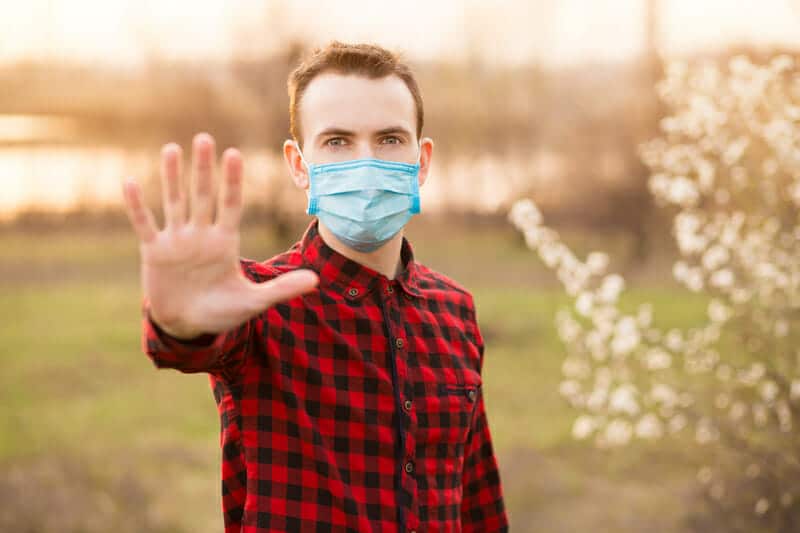
This is the type of information you will not see discussed very often, if at all.
Face masks are imperfect when it comes to limiting the spread of COVID-19, but they also come with their fair share of undesirable side effects.
Every patient should know about the risks, benefits, alternatives, and any other vital information required to make an informed decision.
Some of which will make you second-guess your decision to wear a face mask everywhere you go.
False Illusion of Safety
Most of the published medical studies have had this side effect listed for a long time — the science didn’t magically change when the CDC recommended that everyone wear a face mask.
Due to the sometimes irrational belief people have in the effectiveness of face masks, it may lead them to forget about all the other habits responsible for ensuring one’s safety:
“Wearing a face mask may give a false sense of security and make people adopt a reduction in compliance with other infection control measures, including social distancing and hands washing.
Inappropriate use of face mask: people must not touch their masks, must change their single-use masks frequently or wash them regularly, dispose them correctly and adopt other management measures, otherwise their risks and those of others may increase
The quality and the volume of speech between two people wearing masks is considerably compromised and they may unconsciously come closer. While one may be trained to counteract side effect, this side effect may be more difficult to tackle.
Wearing a face mask makes the exhaled air go into the eyes. This generates an uncomfortable feeling and an impulse to touch your eyes. If your hands are contaminated, you are infecting yourself.”
Anybody who has worn a face mask for several hours at a time will tell you that the longer you wear your face mask, the more likely you are to itch your face:
“Responders who wore masks for longer periods more frequently reported itch.
Almost 30% of itchy subjects reported scratching their face without removing the mask, or after removing the mask and then scratching.
Wearing face masks is linked to development of itch, and scratching can lead to incorrect use of face masks, resulting in reduced protection.”
Plus, remember that we are still in the middle of a hot summer season, and the moisture from the sweat on your face may render the mask ineffective.
The end result is constant re-adjusting, improper removal, and hazardous reuse of masks that are contaminated, moist, and warm.
Even for infected people who aren’t re-inhaling the SARS-CoV-2 particles their body is trying to eliminate, it’s a sure-fire way towards increasing disease within the population.
Not to mention that every thrown-away face mask is a potential biohazard, once you start thinking about where and how they get disposed of.
This is only the tip of the iceberg, because things get a lot worse from here on out.
Skin Irritation
As early as 2009, the negative effects of prolonged face mask usage by healthcare professionals were already obvious:
“After so many hours wearing this form of personal protective equipment, the wearers begin to sweat underneath their masks, causing friction.
This leads to pressure damage on the nose and cheeks, and can result in tears to the skin – opening up the possibility of infection, one more health worry facing healthcare professionals as they continually expose themselves to infected patients.”
This adds on to the earlier point I made about healthcare workers who wear masks for several hours throughout the day.
We now have possible bacterial shedding, a lack of proper use according to several surveys, inconsistent findings with regards to preventing surgical infections, and now this.
Really makes you think!
Re-Inhaling SARS-CoV-2 Particles
Dr. Jim Meehan beautifully describes the problem faced by infected COVID-19 patients who chronically use face masks:
“When you mask someone with an asymptomatic or mild case of CoVID-19, you force the wearer to re-breathe and inhale their own infectious viral particles.
These viral particles need to be cleared from the lungs, not re-inhaled to increase the viral load and worsen the infection.
…The heat and forces of our breathing may fractionate and transform the larger respiratory droplets on the inner surface of the mask into tiny “droplet nuclei” that our breath pushes through and out of the mask, releasing infectious viral particles in an aerosalized form.
In effect, the mask becomes a substrate that atomizes large particles into smaller particles capable of remaining suspended in the local environment for hours.”
Combine this with the hot summer weather, and you have a recipe for disaster:
“If masks determine a humid habitat where SARS-CoV-2 can remain active because of the water vapour continuously provided by breathing and captured by the mask fabric, they determine an increase in viral load (by re-inhaling exhaled viruses) and therefore they can cause a defeat of the innate immunity and an increase in infections.”
However, as you’re about to discover in the next side effect, something far worse happens to your immune system.
Damaged Immune System Response
I once again refer to Dr. Meehan, who also wrote a MUST-READ article about the dangers of wearing face masks.
Continuing on from the previous point regarding increased viral load, the effectiveness of your innate immune system is highly dependent on it.
See, your innate immune response is primarily responsible for several roles.
It helps to destroy the virus, thereby preventing an infection.
If not that, it will decrease infection severity by lowering the viral load.
In other words…your innate immune system’s job is to stop the spread and movement of foreign pathogens in your body as fast as possible.
When you’re re-breathing SARS-CoV-2 and keeping the infection active, you are overloading the innate immune system and it cannot respond appropriately to the virus.
Now, here’s the final and arguably most devastating side effect of them all.
Carbon Dioxide Buildup & Oxygen Depletion
This one will take a while to explain, so bear with me!
Wearing a face mask such as an N95 can lead to changing the composition of the air you breathe:
“Wearing respirator or mask would affect inhaled gas concentrations and respiratory resistances as well.
Particularly, wearing the respirator elevated the carbon dioxide level while decreased oxygen level within the respirator which may be the cause of subjective complaints for wearing respirators.
The increased partial carbon dioxide level also tends to affects breathing patterns and heart rate variability”
This means you oxygen intake is inhibited and your carbon dioxide intake is elevated.
Not only do oxygen and carbon dioxide levels change within the air trapped inside the mask, but the same changes also happen in your blood:
Hypoxia: When body tissue does not get enough oxygen.
Hypercapnia: Elevated levels of carbon dioxide in the blood that can cause dizziness, shortness of breath, headache and, in extreme cases, hyperventilation, seizures and possible death.
Here’s the tricky part: The changes in the blood concentrations of both gases may not be enough to induce either of the conditions, but they can certainly lead to very noticeable changes.
A self-administered survey of 159 young adults (ages 21-35 years old) working in healthcare found that 81% of participants developed headaches which could only be explained by the use of N95 face masks.
Even surgeons who wear surgical masks can experience a decrease in blood oxygen levels (especially if they are over 35), along with an increase in blood carbon dioxide levels when N95 masks are worn for far too long
There is a good reason why healthcare professionals are advised to wear these masks for short periods of time, as they start feeling uncomfortable really quickly.
And it’s the same reason why children and patients with respiratory and/or cardiac problems are advised to avoid using N95 masks.
If you don’t believe me, look at the numerous stories of people who “pass out” after wearing these masks (here and here)
The hypoxia alone is especially harmful, and for numerous reasons…
Hypoxia can induce inflammation, inhibit the immune cells responsible for fighting viral infections, and increase blood pressure.
But the REAL killer about all this is that hypoxia enhances the expression of furin, the protein responsible for cleaving the spike protein on SARS-CoV-2 and thus allowing the virus to enter the cell.
Remember the article I wrote last week about the newest mutation of SARS-CoV-2 being more of a dangerous blood vessel disease than a respiratory one.
Combine that with the arterial deoxygenation and re-breathing of CO2 caused by chronic face mask usage, and you’ve now turned a mildly infected COVID-19 patient into a ticking time bomb.
It’s also bad for your deoxygenated brain, which COVID-19 can also gain access to.
(ALSO Need to mention this to show that this is not made up: https://apps.who.int/iris/handle/10665/331693)
I’m not making any of this up, by the way — these same disadvantages have also been thoroughly documented by the WHO.
Why Do Certain Eastern Countries Show “Success” With Wearing Face Masks?
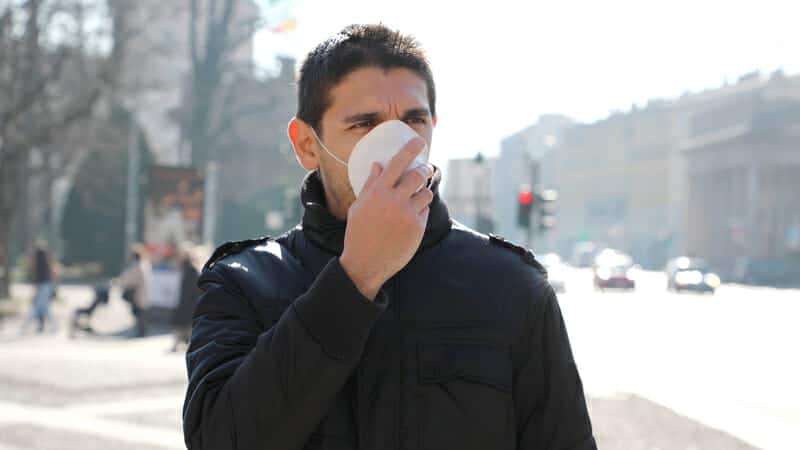
Despite the abundance of evidence that clearly presents a compelling case against face masks, we still have one more question to answer.
If masks are so awful, can you explain why countries that successfully responded to COVID-19 have universal face mask usage as a prominent feature of their pandemic response?
This article is far too dense to break down every single country, but I will highlight a few countries receiving a lot of attention from the mainstream media.
Taiwan
When you hear about the success of Taiwan in containing COVID-19 and rapidly re-opening their economy, here is a good summary of the reason why they were able to do so
“Taiwan and Hong Kong both adopted community-wide masking early in the pandemic.
Without resorting to lockdowns and restrictive social distancing measures, they maintained low rates of COVID-19 infections throughout the pandemic (19 and 141 per million population respectively, as of 17 May).
Their infection rates are significantly lower compared with other countries that did not adopt this practice”
I won’t deny their success for a second — a population of 21.7 million experiencing only 451 infections and just 7 deaths is nothing to scoff at.
What doesn’t get fully disclosed is that Taiwan followed what you could call the “gold standard pandemic response”:
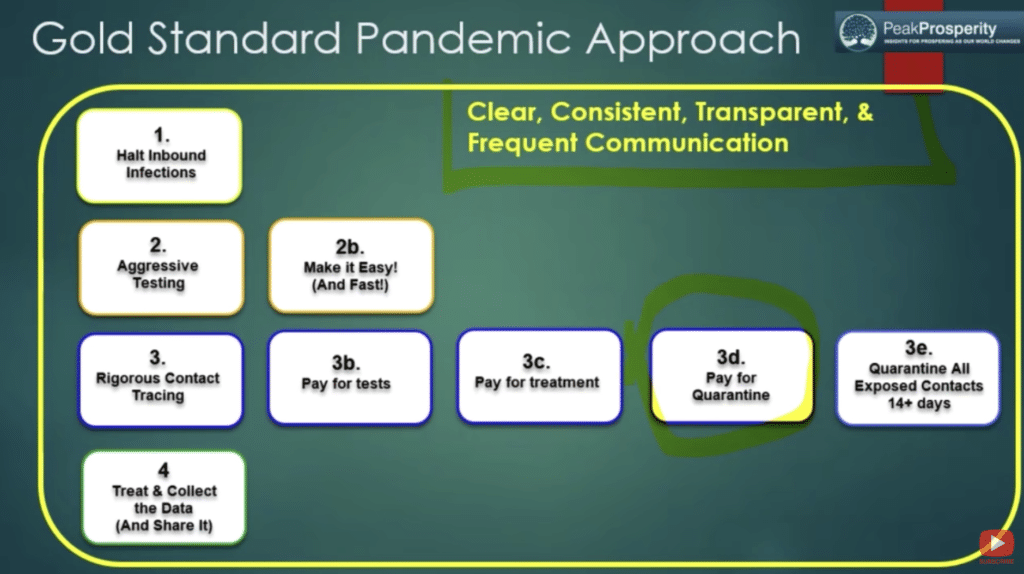
Here are all the actions Taiwan took when they saw COVID-19 coming their way:
- Screened all incoming passengers from Wuhan in late December
- Blocked flights from China while quarantining anybody coming from an infected zone
- Gave daily public updates about the locations visited by infected patients prior to their COVID-19 diagnosis
- Stockpiled on 44 million masks
- Public places could not be entered until visitors thoroughly disinfected their hands
- Set up a hotline for citizens to report “suspicious” symptoms
- Implemented strict border control for boats and aircraft
- Using effective therapeutics
- Created a robust contact tracing system and reported the results as soon as they were available
- Developed their OWN highly reliable COVID-19 tests and rapidly scaled them
- Actively encouraged people to follow best practices (i.e. hand washing, social distancing)
As the quoted article concluded:
“Through early recognition of the crisis, daily briefings to the public, and simple health messaging, the government was able to reassure the public by delivering timely, accurate, and transparent information regarding the evolving epidemic”
Most importantly, they followed through on all of these actions AGGRESSIVELY and IMMEDIATELY, largely in thanks to the game plan they developed after the 2003 SARS epidemic (more here).
Don’t forget that the Taiwanese are generally collectivist in nature, which fosters widespread collaboration and adherence to their pandemic response:
- Social rules focus on promoting selflessness and putting community needs ahead of individual needs.
- Working as a group and supporting others is essential.
- People are encouraged to do what’s best for society.
- Families and communities have a central role.
- There is a greater emphasis on common goals over individual pursuits.
When you put ALL of those variables together, Taiwan’s success is self-explanatory.
Japan
Japan has also received worldwide praise for their long history of using face masks, as evidenced by the viral tweet below:
https://twitter.com/Robin_Blue19/status/1282479222691438592
When people realize that Japan’s death rate was 2% of America’s death rate in early May, everyone attributed universal mask-wearing as the #1 explanation.
With 16,581 cases and 830 deaths for a population of ~126 million, their pandemic response is also worth further examination.
Once again, we need to look at all of the actions taken by Japan to fight the first wave of SARS-CoV-2:
- Japan is one of the healthiest populations in the world, while also having the lowest obesity rates (supremely low levels of systemic inflammation)
- A highly successful universal public healthcare system
- Employed aggressive contact tracing on clusters of “superspreaders” despite limited testing capabilities – i.e. transmission happens through 20% of infected people, but they infect several people at once
- Encouraged people to avoid ‘the three C’s’ – “closed spaces with poor ventilation, crowded places with many people nearby and close-contact settings such as close-range conversations”
- Hand washing, face masks, keeping a clean environment, and social distancing were already ingrained habits
Overall, Japan’s approach was controversial to the rest of the world as they took on a more relaxed approach.
And just like Taiwan, Japan is a highly collectivist culture which prioritizes the collective over the individual under the belief that individual wellbeing stems from collective wellbeing:
“The Japanese approach to this meant that many policies other countries adopted in response to the pandemic – especially related to cleaning and social distancing – effectively existed in Japan even before any emergency declaration was issued…both in terms of respect for others and cleanliness.
Of course, Japan did have to make changes, such as ensuring the widespread availability of disinfectant to clean hands in any public building, educating people via targeted messages in cities, keeping windows opened in trains and subways, chair distancing in cafeterias of universities, industries and restaurants, and limiting travelling, but these went down well in communities used to doing what is necessary to keep the environment safe and clean.”
One more thing worth pointing out…
Many of the studies vouching for the efficacy of masks are based on correlations and retrospectively analyzing trends over time.
While these studies have validity to them, it’s easy to “fit the curve” and create the desired narrative.
So unless you control for every other variable which could affected the outcome being studied, an inaccurate conclusion can be reached.
As I said earlier in the article, randomized controlled trials are at the top of the hierarchy when it comes to evidence-based science.
Until you have well-done RCTs, all you have is speculation… which should be used with extreme caution when determining public health policy.
And when you look at the two STRONGEST mitigators for viruses like SARS-CoV-2, hand washing and social distancing almost always come out on top:
“During the 2009 pandemic of H1N1 influenza (swine flu), encouraging the public to wash their hands reduced the incidence of infection significantly whereas wearing facemasks did not. There is no good evidence that facemasks protect the public against infection with respiratory viruses, including COVID‐19” (Source)
“The latest recommendation by the CDC regarding cloth masking in the public may help slow the progression of the pandemic. However, it is of paramount importance to keep in mind that masks alone are not enough to control the disease and must be coupled with other non-pharmacological interventions such as social distancing, quarantining/isolation, and diligent hand hygiene” (Source)
“We conducted a systematic review of the primary literature, pooling data where possible and appropriate to arrive at quantitative estimates of intervention effectiveness. The primary finding was that regular hand hygiene was significantly protective in protecting from pandemic influenza infection, while facemask use was not significantly protective” (Source)
And last, but certainly not least:
“Universal public masking was adopted in Singapore, South Korea, Hong Kong, mainland China, Thailand, and Taiwan after their respective COVID-19 outbreaks and may have contributed to their initial success rates to curbing transmission, along with widespread testing, isolation and quarantining, contact tracing, and border control measures” (Source)
When in doubt, look at the ENTIRE picture!
Sweden
Sweden is by far the most interesting country to look at, as their ultra-relaxed approach was in direct contradiction to the panic-induced lockdowns imposed by most other countries.
In fact, they didn’t enforce a lockdown at all:
“…temporarily banning gatherings of over 50 individuals, banning people from visiting nursing homes, and physically closing secondary schools and universities. Primary schools have remained open, in part to avoid healthcare workers staying home with their children.
The Public Health Agency issued recommendations to: if possible, work from home; avoid unnecessary travel within the country; engage in social distancing; and for people above 70 to stay at home, as much as possible. Those with even minimal symptoms that could be caused by COVID-19 are recommended to stay home.”
For the most part, the economy was left wide open, the Swedish government trusted its people to follow basic protocols (social distancing, wearing face masks, practicing good hand hygiene, etc.), and care was prioritized to protect the sick and elderly.
All of this was done under the implied premise of achieving herd immunity, which involves intentionally allowing people to be infected:
“Herd immunity occurs when a large section of the population (generally considered to be between 50% and 90% depending on how contagious the infection is) becomes immune to a disease or virus, therefore stopping its spread.
This occurs when people have enough antibodies to repel the virus—either through having been exposed to the virus and survived, or through vaccination”
This approach wasn’t without its faults, as only 7.3% of the population developed herd immunity by the end of April.
But in all fairness, antibodies are only one part of the story, as the immune system is far more complex in nature:
“Most of these studies show that people who have recovered from infection have antibodies to the virus. However, some of these people have very low levels of neutralizing antibodies in their blood,4 suggesting that cellular immunity may also be critical for recovery.”
In other words, it’s possible to lack antibodies (or be genetically unable to produce them) while still having some immunity to COVID-19 because the immune system has several mechanisms of action for attacking foreign agents.
“The fact that many people infected with SARS-CoV-2 will clear the virus without even developing symptoms suggests that the immune system may hold the key to defeat this virus.
While surely this involves adaptive immunity and suggests vaccination will play a central role in ameliorating this pandemic, we would like to propose harnessing innate immunity as a potential approach to immediately combat COVID-19″
The second major criticism of Sweden’s approach is that their death rate per capita was rather high, sitting at 10-20x the death rates observed in Norway, Finland, and Denmark (90% of coronavirus-induced deaths were in seniors 70 years old and above).
Granted, this was one of the major mistakes they made, but it was the “right” mistake.
Before you lose your mind, allow me to elaborate…
There is a shadow pandemic coming to places like the United States, and that pandemic involves a REAL cost: Human life.
Just take a look at the rampant number of suicides projected to take place:
“The looming economic crisis may create panic, mass unemployment, poverty and homelessness will possibly surge the suicide risk or drive an increase in the attempt to suicide rates in such patients.
US already claimed a vast increase in unemployment (4.6 million) during coronavirus emergency and speculated that lockdown will cause more deaths than COVID-19 itself amid the current and coming recession(depression).
This uncertainty of time for isolation, not only demoralize but also make people feel worthless, hopeless about present and future “
It is well established in the field of economics that recessions automatically lead to the loss of life:
Statistically, every $10 million to $24 million lost in U.S. incomes results in one additional death.
One portion of this effect is through unemployment, which leads to an average increase in mortality of at least 60 percent.
That translates into 7,200 lives lost per month among the 36 million newly unemployed Americans, over 40 percent of whom are not expected to regain their jobs.
…With an average estimate of one additional lost life per $17 million income loss, that would translate to 65,000 lives lost in the U.S. for each month because of the economic shutdown.”
However, you also have to factor in “life years” (i.e. the number of years of potential life lost due to an early death):
“If we only consider unemployment-related fatalities from the economic shutdown, that would total at least an additional 7,200 lives per month.
Assuming these deaths occur proportionally across the ages of current U.S. mortality data, and equally among men and women, this amounts to more than 200,000 lost years of life for each month of the economic shutdown.”
Imagine what is happening to the many millennials and young adults facing job loss and financial instability.
The amount of psychological trauma induced by the lack of means to learn a living, being isolated in their home, and struggling to eat is indescribable.
Sweden has recognized this truth on some level, which is why they refused to lockdown the economy and instead allow the majority of businesses to stay open (albeit with regular checks to ensure people social distancing).
So in a weird sense, they managed to dodge a bullet that is headed straight for the economies of the globe.
And I would certainly not hail Sweden as a model of success with regards to how they responded and what they could have done better.
However, we WILL NOT know the full extent of the achievements and the downfalls of various pandemic responses until we are 5-6 years into the future.
Only then can we know for sure who “got it wrong” and who “got it right”.
But have no fear – if the topic of death frightens you in any way, you will definitely want to read the final section of this article!
How Masks Lead to Spiritual Dissonance And Low-Vibration Victimhood
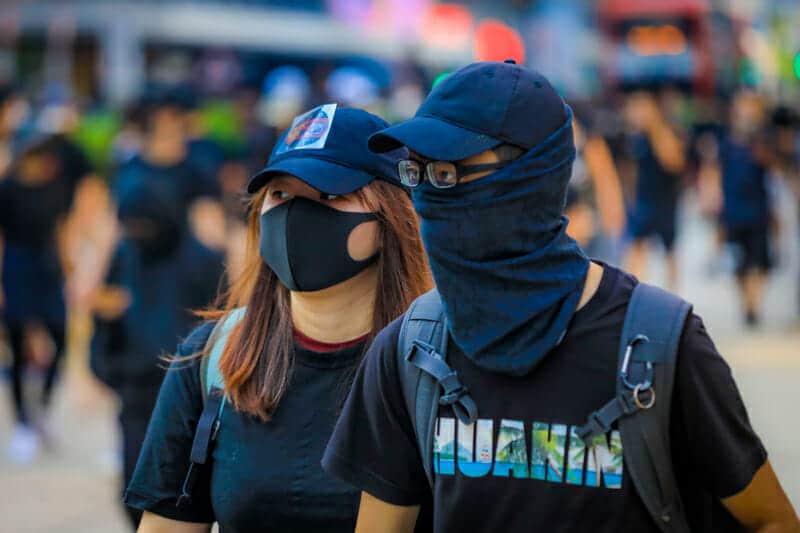
Every single piece of important information I want to convey to you about the current times can be found in my video below:
“The party told you to reject the evidence of your eyes and ears.
It was their final, most essential command.”
– George Orwell, 1984
Please understand that forcing the world to wear masks goes above and beyond any cause or concern for health:
“We are being conned with a manufactured terror campaign by a power bloc that considers the bulk of ordinary society a herd to be manipulated.
The many who understand this, but who nevertheless wear a mask simply to conform to what they assume to be majority agreement, are allowing themselves to become part of the con”
The wearing of masks has been a major part of of occult rituals for several centuries, and its TRUE meaning is far more sinister than you can possibly imagine:
“…the wearing of the mask over one’s mouth is a token of submission…a gesture of your willingness to be subject to others who are not your usual Sovereign.
…According to the Encyclopedia Britannica, mask-wearing is ‘A form of disguise or concealment usually worn over or in front of the face to hide the identity of a person and by its own features to establish another being.'”
In other words, the wearing of a mask represents an occult transformation — a human alchemy, if you will — from one role to another. From one manner of being, to another. Indeed, in this case, from individual sovereign under God to collective subject under the children of the devil.
And with your individual identity completely dissolved into nothingness, you can be shaped and transformed into whatever the “powers that be” choose:
“This specific social climate is pure gold for social engineers who are looking to profoundly alter society.
A society that is subjected to fear and panic becomes irrational and readily accepts any measure that promises some kind of safety.
And this is what is happening now.”
A gentleman who left a profound comment on my YouTube channel says it best:
“Mask wearing when not ill is sinister behavior.
It is about control, and willfully blinding subservience to evil.
A very bold leap forward in the centuries long plan to abolish human kind by abolishing humanity.”
Wearing a mask is no different from choosing to wear a mind control device controlled by somebody who IS NOT YOU:
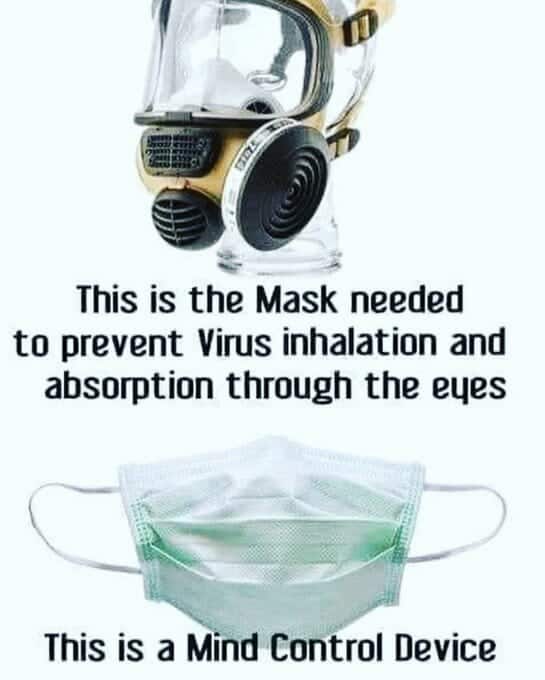
With regards to our own spirituality and health, masks only do three things.
- Lower your vibration, increasing FEAR, STRESS and CORTISOL (all of which naturally lower immunity)
- Impair breathing when walking or exercising
- Further exacerbate contaminants or infectious agents being recirculated
People who evangelically believe in the value of face masks are either uninformed(not anymore if they CHOOSE to read this article), living a fear-based life (due to vibrating at a level of consciousness dissonant and incoherent), or in poor health due to co-morbidity from prolonged inflammation (living a shitty lifestyle).
Just take a look at the 32% of young adults ages 18-25 who are vulnerable to severe COVID-19 infections… they either have an existing co-morbidity, and/or they smoke cigarettes/JUULs!
It’s no wonder many are so unbalanced and vibrating in victimhood.
If only they knew disease comes from INFLAMMATION from internally manifested stress from unintegrated trauma in your past and current life.
Each of us must learn to allow and accept our traumas before working to integrate them.
NOBODY on planet Earth with any level of awareness should be in fear of anything.
“The body of man is eternally repetitive.
It forever appears, disappears, and reappears in cycles.
We call the cycles of man’s appearance and disappearance life and death; but bodies, never having lived cannot die.
There is no death in all the universe.
There is but a continual repetition of life cycles of rebirth into their two opposite expressions which we call life and death, but both are, in fact, one.”
Knowing that, why would you fear death?
Why would you be afraid of COVID-19, or anything?
You are merely vibrating electrons(a base essence of spirit).
You ARE NOT your physical body.
If you go outside and see other people refusing to wear a mask, don’t chastise them.
Instead, focus on being kind, caring, loving and non-judgmental in your interactions with everyone.
BE OF SERVICE to the greater good!
If you read this article and learned anything from it, you realize the absolute best measure you have against COVID-19 or any ‘disease’ is a healthy avatar body via a clean lifestyle and a raised vibration.
Living Your Life Fully Optimized, can’t hurt either.
And please remember to:
RAISE YOUR VIBRATION TO OPTIMIZE YOUR LOVE CREATION!
A Comprehensive Collection of Scientific Evidence Refuting the Effectiveness of Face Masks
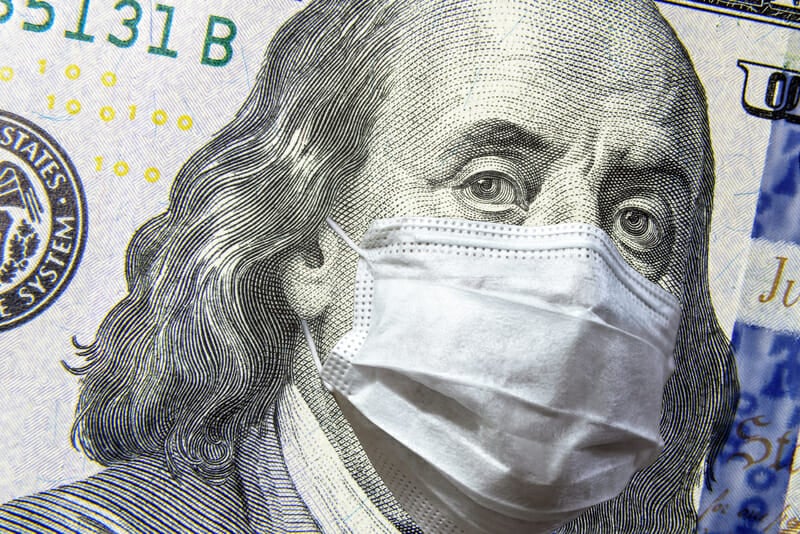
If you feel as if you have taken the “red pill” and want to go deeper down this rabbit hole, I’ve compiled several high-level resources for you:
Dr. Buttar’s comprehensive rebuttal of face masks using several studies, and his video explaining the evidence
(NOTE: I am only referencing Dr. Buttar’s material, and NOT endorsing the London Real scam)
Dr. Jim Meehan’s article on the dangers of face masks that heavily inspired me to write this article
Dr. Denis Rancourt’s systematic review on face masks, outlining why an empirical test of a nation-wide mask-wearing policy is basically impossible
Jennifer Kozek’s interpretation of the science “supporting” face mask usage
Dr. Pamela Popper’s premium newsletter on the effectiveness of face masks against COVID-19, and her video dictation of the article.
A lawyer’s take on why Dr. Fauci’s reversal on face mask recommendations is a TOTAL FARCE!
A must-see video on an American’s right to refuse to wear a mask in public
Dr. Russell Blaylock’s review of the side effects of face masks, focusing on hypoxia
Dr. Richard Bartlett’s video interview about the up-to-date science on SARS-CoV-2
A mega-thread on Twitter exposing many of the mainstream lies about anything and everything related to COVID-19
Thank you for reading this entire article and choosing to expose yourself to information that is more often than not occluded from the mainstream echo chambers of dissonance and incoherence.
If you want access to the world’s best health optimization intel before anybody else finds out about it, don’t forget to subscribe to my email list!





